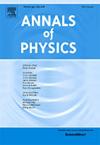Wormholes stability from a class of (2 + 1)-dimensional regular black holes
IF 3
3区 物理与天体物理
Q2 PHYSICS, MULTIDISCIPLINARY
引用次数: 0
Abstract
Here, we investigate the stability, and the effect of different parameters on the stability, of a class of nonrotating thin-shell wormholes formed by nonrotating lower-dimensional non-linear electrodynamics regular black holes. We find that the event horizon radius shifts outward when the parameter and the black hole charge are increased, as seen in the graph of the metric function (). This suggests that these factors significantly affect the location of the horizon. Furthermore, the black hole’s mass is critical; wormholes with larger masses are more stable, whereas wormholes with smaller masses have smaller stability zones. As the equation of state parameter varies across multiple values, more research reveals the effect of diverse matter compositions on the stability of nonrotating thin-shell wormholes. We identify stable configurations with a concave-up potential function for configurations where . On the other hand, dark energy configurations () are stable as well, whereas phantom energy configurations () cause instability with a concave-down potential. An examination of generalized Chaplygin gas reveals that specific kinds of matter can cause wormhole structures to become unstable. This sheds light on the intricate yet vital connection between the state equations and the stability of thin-shell wormholes, which can direct subsequent theoretical investigations in spacetime physics.
一类(2 + 1)维规则黑洞的虫洞稳定性
本文研究了一类由非旋转低维非线性电动力学规则黑洞形成的非旋转薄壳虫洞的稳定性,以及不同参数对稳定性的影响。我们发现,当参数L和黑洞电荷增加时,视界半径向外移动,如度量函数(G(r))的图所示。这表明,这些因素显著影响地平线的位置。此外,黑洞的质量是临界的;质量较大的虫洞更稳定,而质量较小的虫洞稳定区更小。随着状态参数方程在多个数值上的变化,更多的研究揭示了不同物质组成对非旋转薄壳虫孔稳定性的影响。对于χ>;−1/3的配置,我们用一个凹化的势函数来识别稳定的配置。另一方面,暗能量配置(χ<−1/3)也是稳定的,而幻能配置(χ<−1)则导致不稳定,具有向下凹的电位。对广义Chaplygin气体的研究表明,特定种类的物质可以导致虫洞结构变得不稳定。这揭示了状态方程与薄壳虫洞稳定性之间复杂而重要的联系,可以指导后续的时空物理学理论研究。
本文章由计算机程序翻译,如有差异,请以英文原文为准。
求助全文
约1分钟内获得全文
求助全文
来源期刊

Annals of Physics
物理-物理:综合
CiteScore
5.30
自引率
3.30%
发文量
211
审稿时长
47 days
期刊介绍:
Annals of Physics presents original work in all areas of basic theoretic physics research. Ideas are developed and fully explored, and thorough treatment is given to first principles and ultimate applications. Annals of Physics emphasizes clarity and intelligibility in the articles it publishes, thus making them as accessible as possible. Readers familiar with recent developments in the field are provided with sufficient detail and background to follow the arguments and understand their significance.
The Editors of the journal cover all fields of theoretical physics. Articles published in the journal are typically longer than 20 pages.
 求助内容:
求助内容: 应助结果提醒方式:
应助结果提醒方式:


